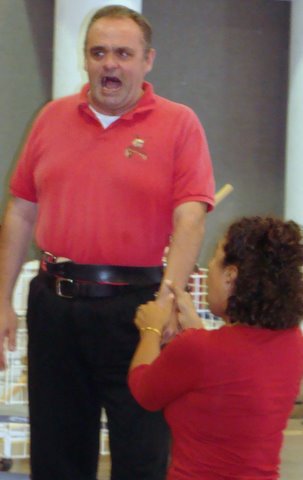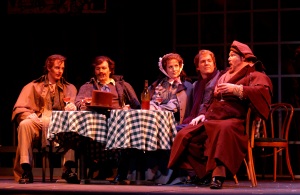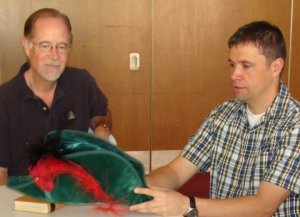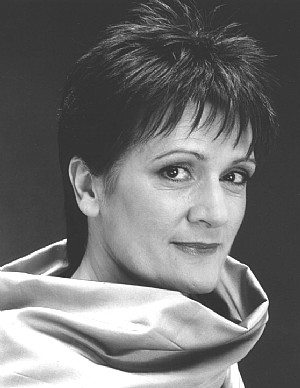Usually I don’t presume to make book recommendations, but in this instance, I feel the need to make an exception. While the book I’m about to recommend tells the story of a magnificent singer, opera is secondary. This is an incredibly compelling human tale that kept me riveted from beginning to end. More about that in a moment. . .
Backstory

Hao Jiang Tian
This spring I was very fortunate to conduct a production of Faust for the Fresno Grand Opera. The principals included three renowned Metropolitan Opera singers: soprano Maureen O’Flynn, tenor Fernando de la Mora, bass Hao Jiang Tian, and La Scala veteran, Luis Ledesma. I have to admit that I was a little apprehensive in the days leading up to the first rehearsal. These were all singers who had sung all over the word, in all of the biggest opera houses, and l was coming into this as low man on the totem pole.
I very quickly found that I had no reason to be nervous. While all were quintessential professionals, they were also warm and collegial professionals who offered me the same deference they would offer to the most famous of conductors. We quickly became a lively group of friends, who looked forward to socializing and having dinner together after rehearsals. We even spent our first day off together taking a guided tour of Yosemite Park with one of our fabulous Fresno hosts.
We also were a virtual United Nations of origins. Fernando and Luis are from Mexico; Fernando’s wife is from France; Maureen and I share Irish ancestry; Maureen’s husband, Claude Corbeil, (a wonderful bass) is French Canadian; and Tian and his wife, Martha, are from China.
One of my favorite memories from those three weeks came while waiting in front of our hotel for the beginning of the Yosemite tour. We learned that it was Claude’s birthday that day, and immediately Fernando and Luis burst into a traditional Mexican birthday song, in two part harmony, that went on for a good four our five minutes. As you might expect, a sidewalk serenade by two world class opera singers began to draw attention, and people stopped what they were doing and stared in amazement. “Who are you people?” one of them asked when the “concert” had come to a dramatic conclusion.
Along the Roaring River

Hao Jiang Tian as Mephistopheles at The Met.
Back to the book. During our three weeks together, Hao Jiang Tian (he is addressed as Tian) held a book signing for his new book, which I attended not really knowing anything about his early background. What I knew of him was that he was a wonderful artist, and one of the most polite and friendly people that I had ever met. I couldn’t help wondering how—with this underlying warmth—he could transform himself into the wrathful evil that is Mephistopheles. (Oh, but he did!) You would think he was shy, but that would only make his mischievous rehearsal interjections even funnier.
What I heard at his book signing was an absolutely incredible story. Tian was the son of a symphony conductor in Beijing when the Cultural Revolution erupted. He recalled having to destroy his father’s entire record collection of western music by smashing each disc into little pieces, and his no longer having to take the “dreaded” piano lessons. At the time, both were welcome developments, much to his embarrassment now. His parents were influential in the Communist Party, and it was important for them all to be politically correct, even in their musical tastes.
He next told us of how he soon developed an interest in American popular music after being given a guitar by his older brother, and he performed several of his favorites, in very entertaining English, accompanying himself on the guitar and piano. These had been learned by hiding under the blankets at night and listening to one of the western Radio Free stations that he could get on a transistor radio. It he had been caught, he could have been arrested!
Once out of school, Tian worked in a boiler factory. One day he cycled across Beijing to see a friend and, at the friend’s high rise apartment, stood on the sidewalk and yelled his friend’s name, louder and louder. Finally a window opened and a man leaned out, commenting on the carrying power of Tian’s voice and told him to come upstairs. The man told him that he should become a singer.
Against unbelievable odds, the path of this undeniable talent changed; the world of opera would be changed as well. After time at a Chinese conservatory, Tian took the plunge and traveled to the United States. He landed in the U.S. with nowhere to go, speaking no English, and with $30 in his pocket, of which he spent $18 to buy a standing room ticket at the Metropolitan Opera. At intermission, departing patrons gave him a ticket for fifth row, center, and there he was, just yards away from James Levine in the pit, and Luciano Pavarotti on stage.
It was just ten years later, almost to the day, that Tian performed at the Met for the first of many times, with both Levine and Pavarotti.
Toward the end of our time together, Tian came to me and said, “We have been talking about you. You may be one of the quietest maestros we know, but you have it here.” And he thumped his heart. That is the kind of person he is.
These are just a few examples of how Tian came to be the amazing star and wonderful human being that he is today. I wish that you all could meet him in person. As Placido Domingo said about him, “Tian has had a life worthy of an opera!”
I encourage you to read the rest in his book. The full title is Along the Roaring River: My Wild Ride from Mao to the Met. You can hear Tian’s magnificent voice and learn more about him at his website: tianhaojiang.com
Happy reading!
Jim





















